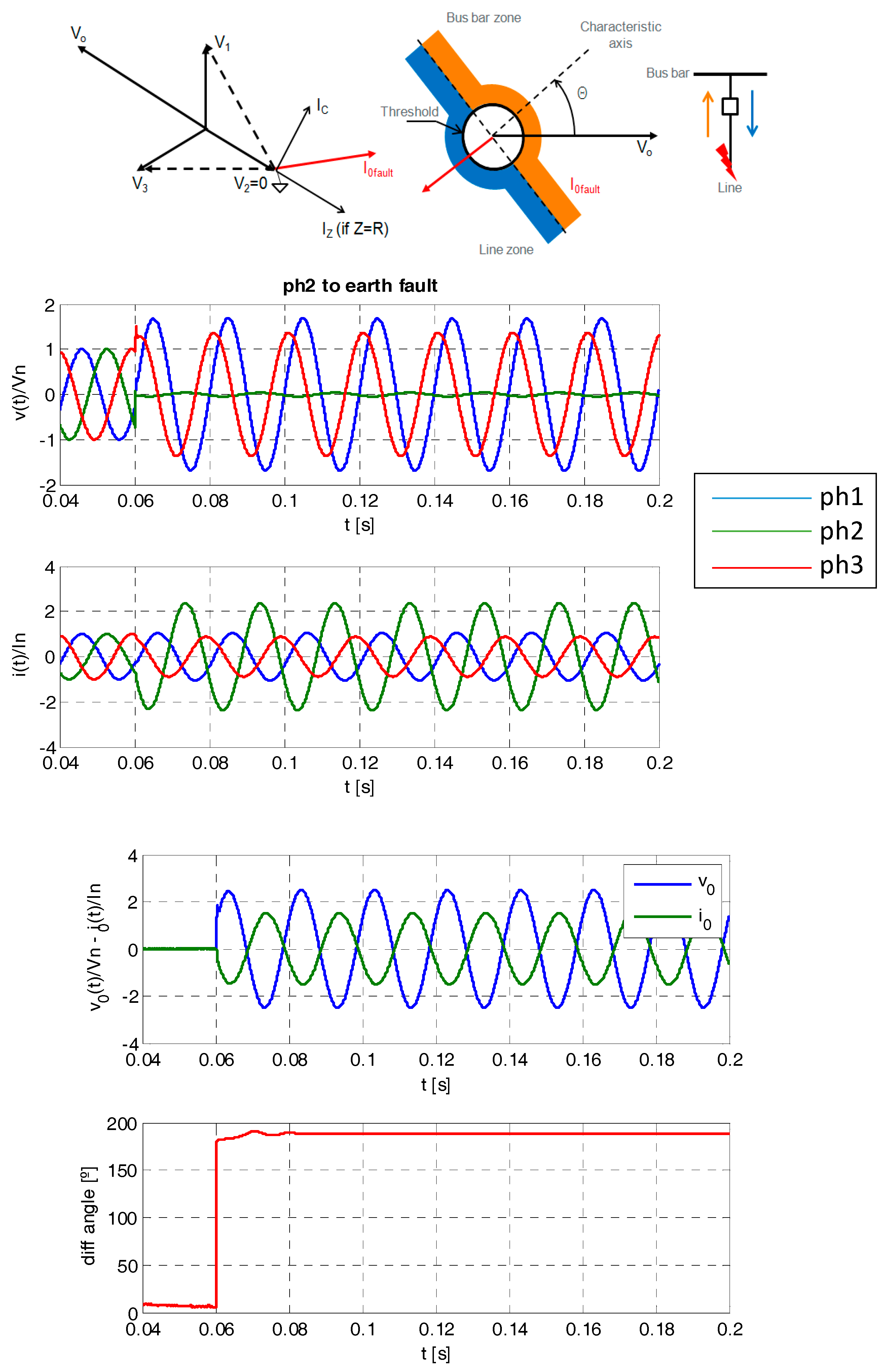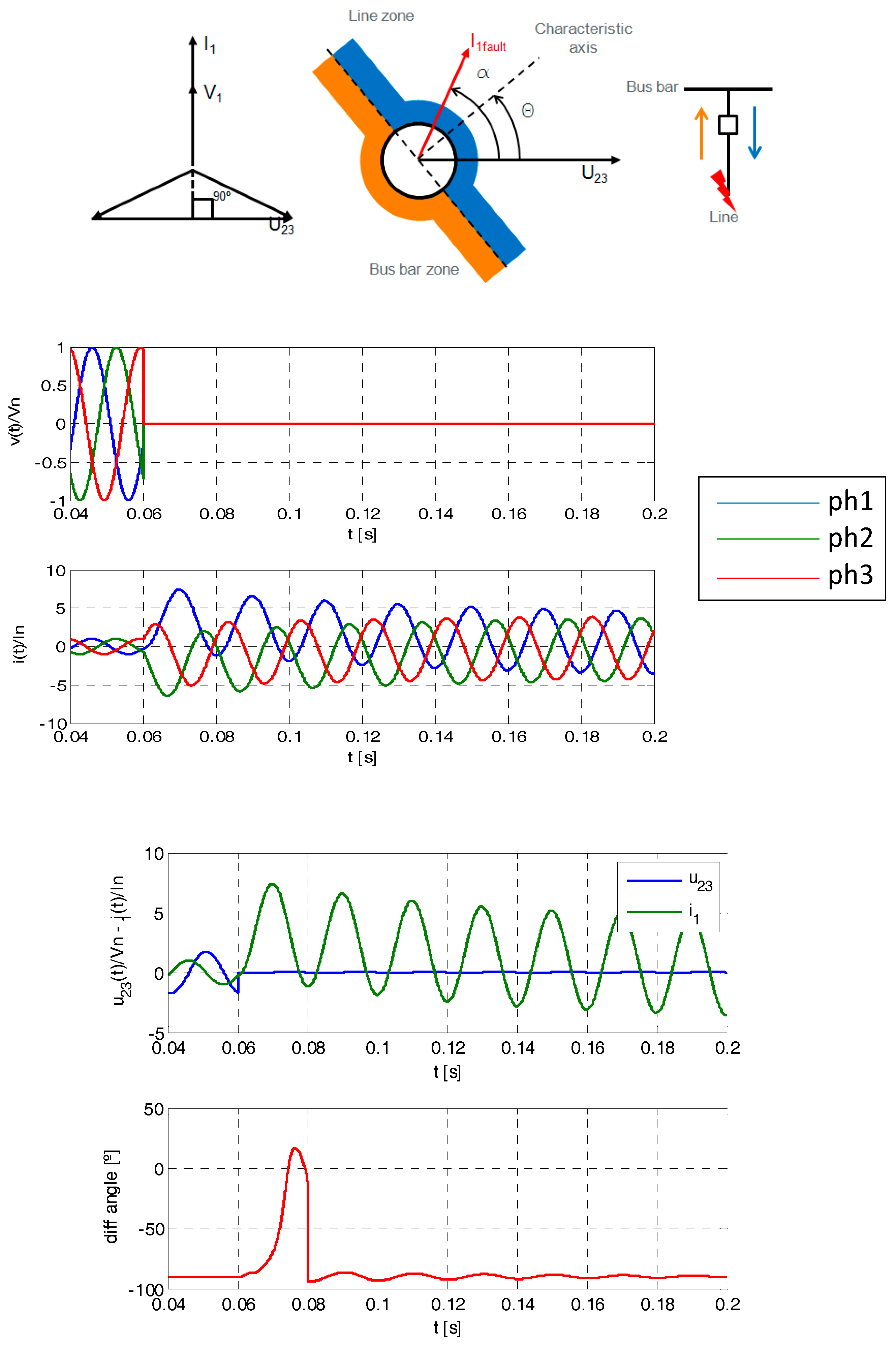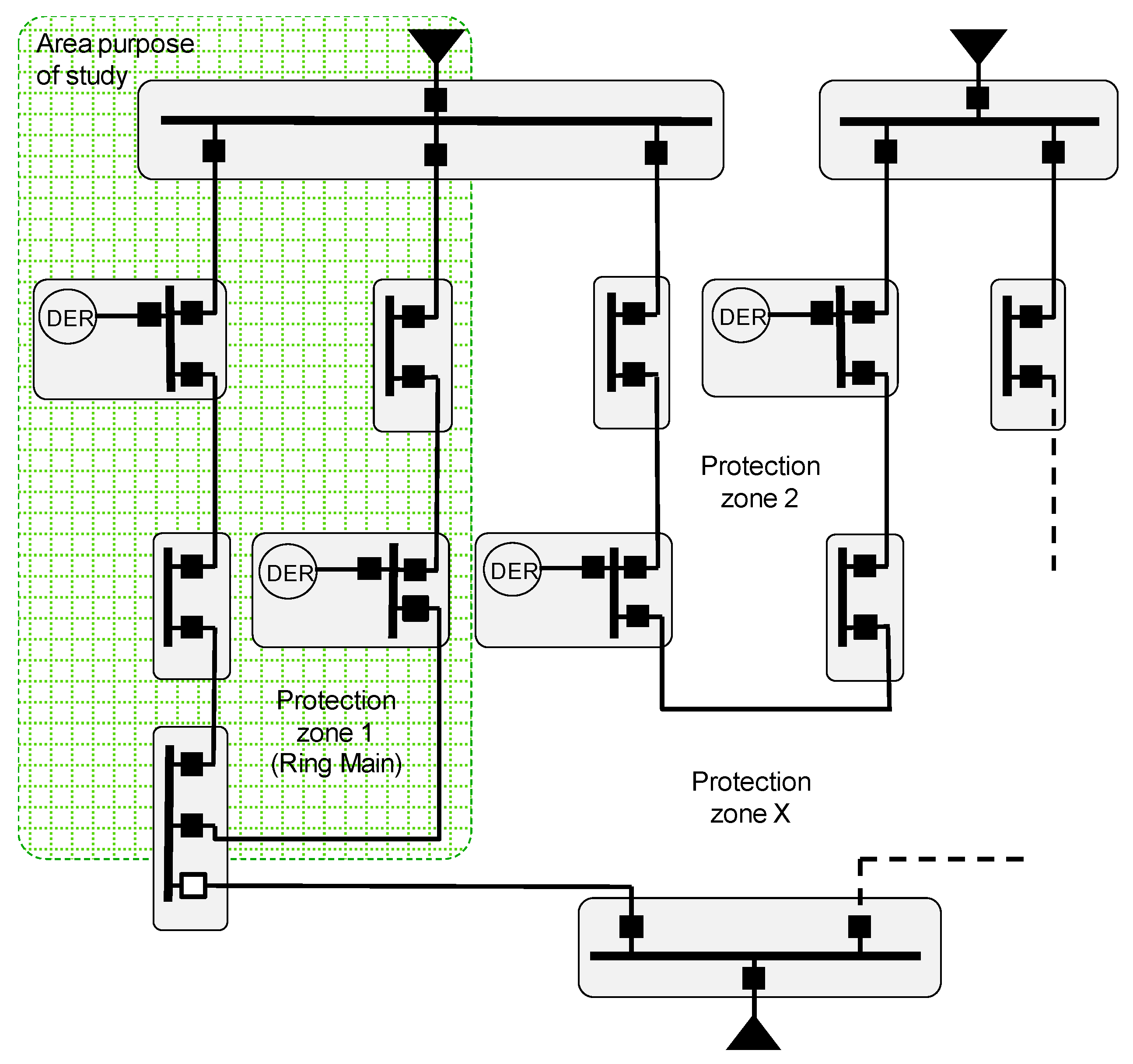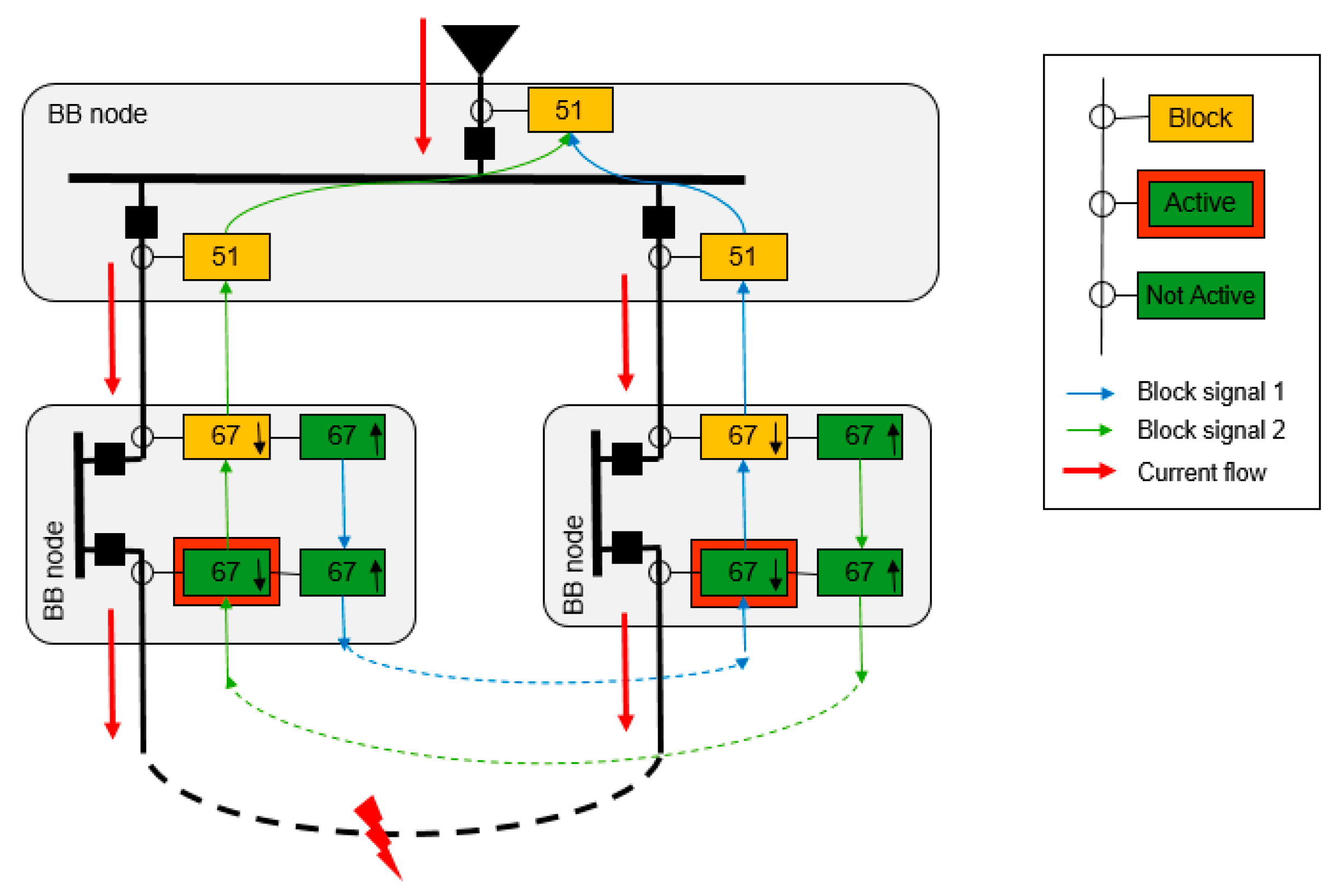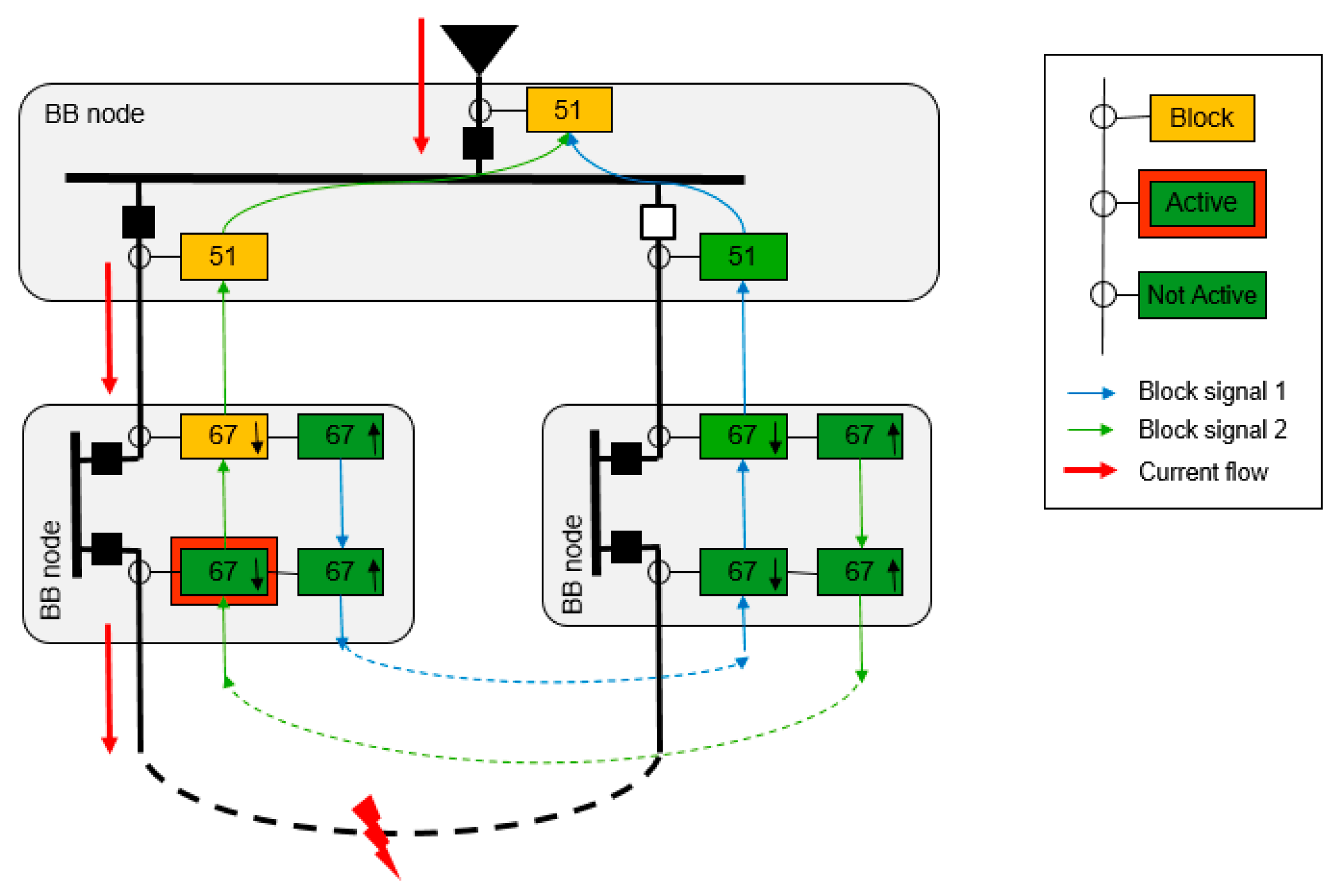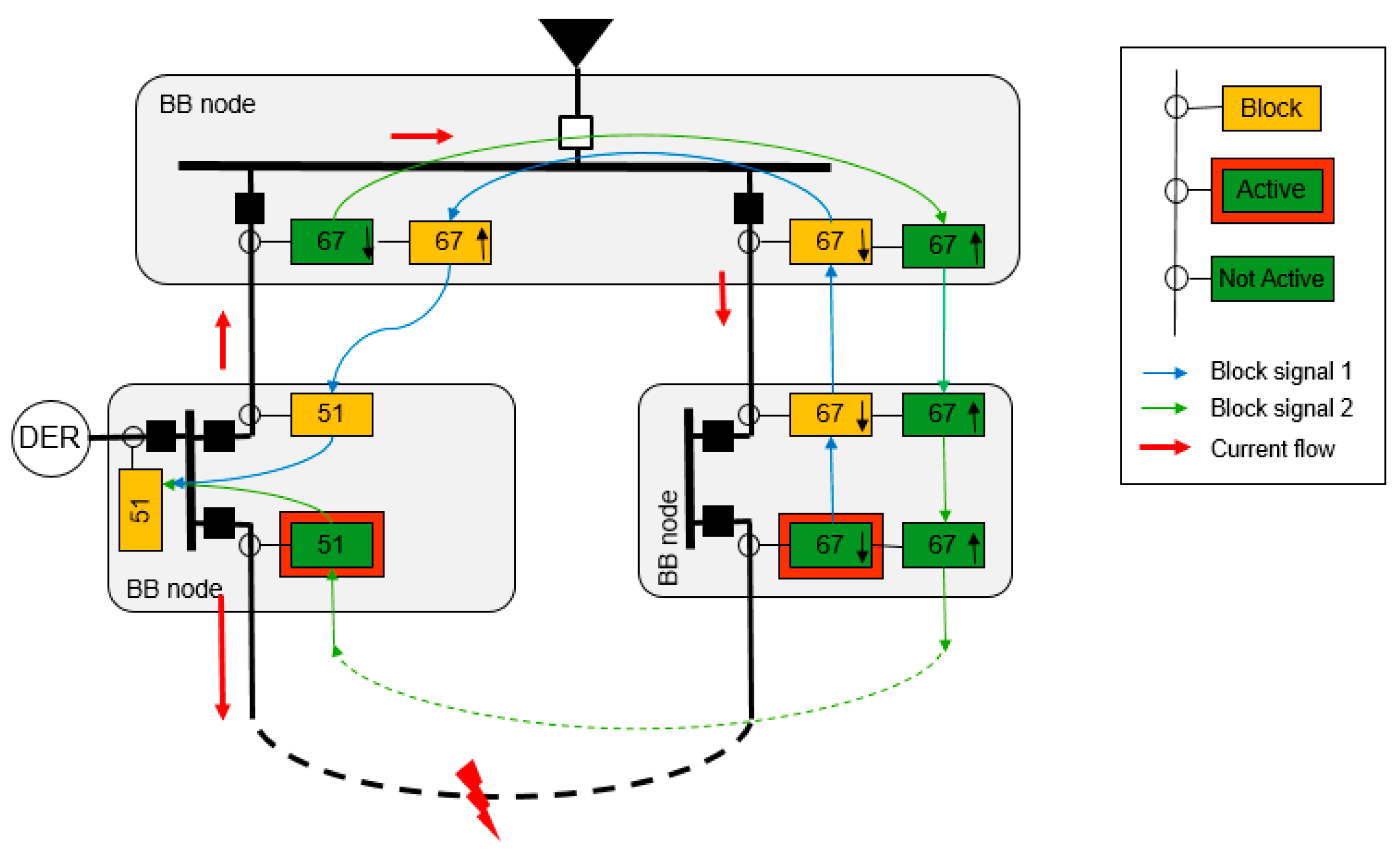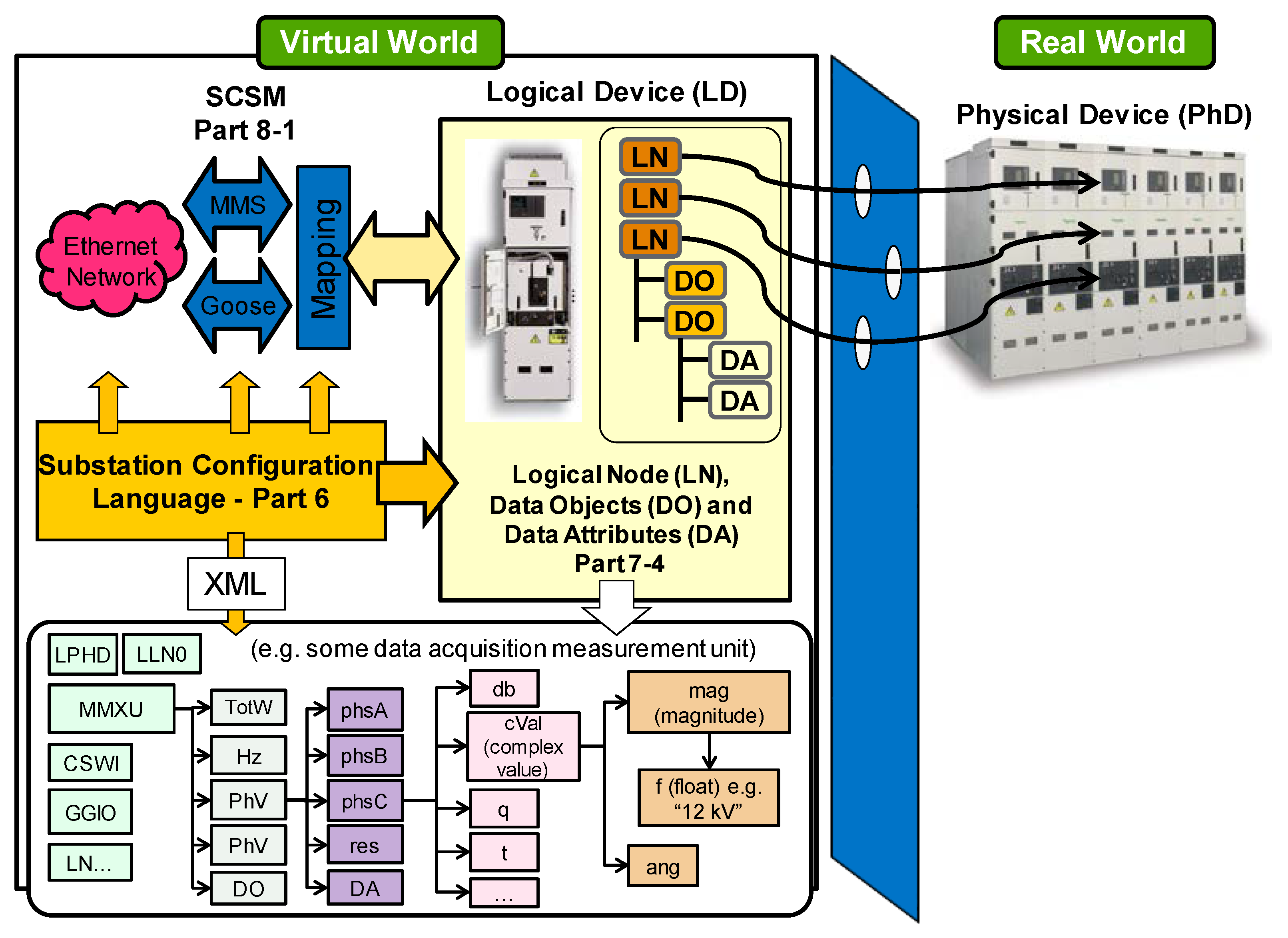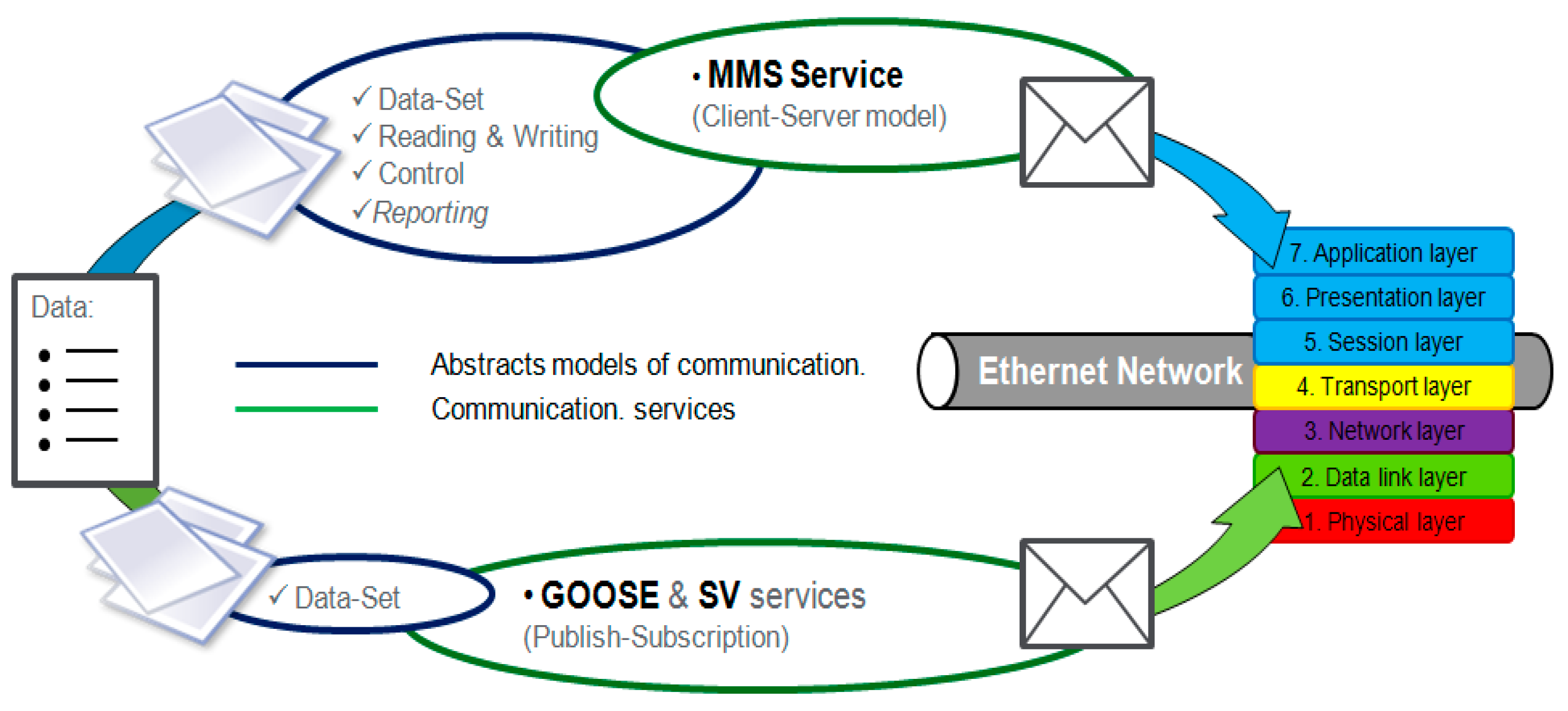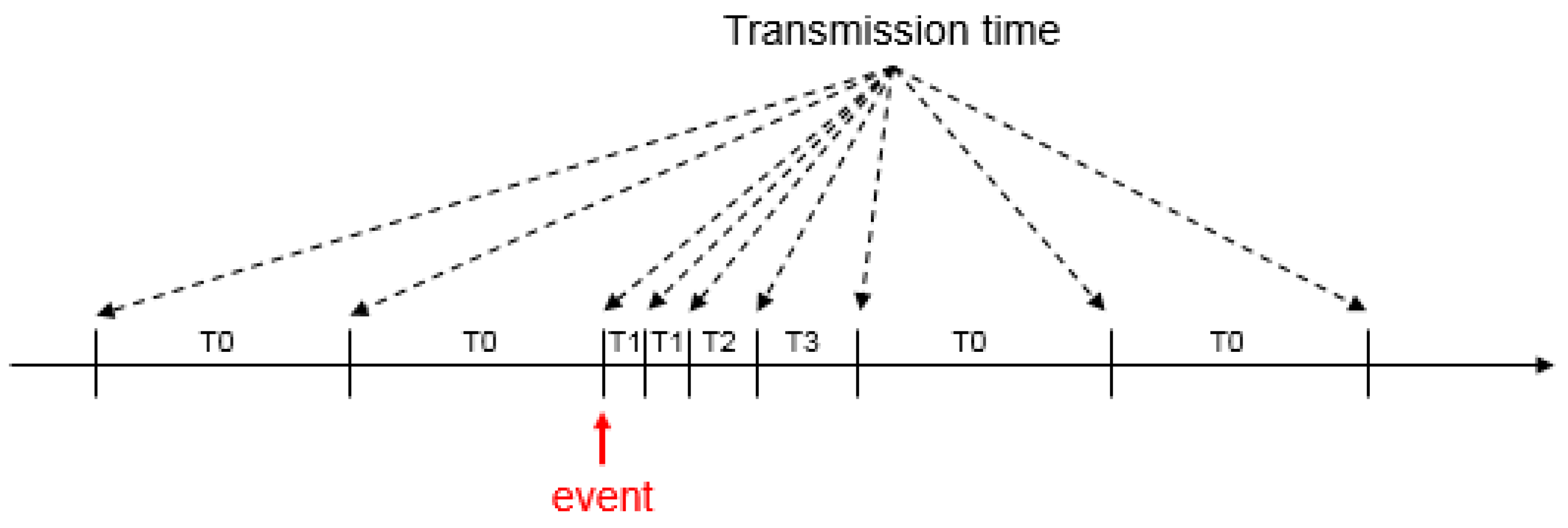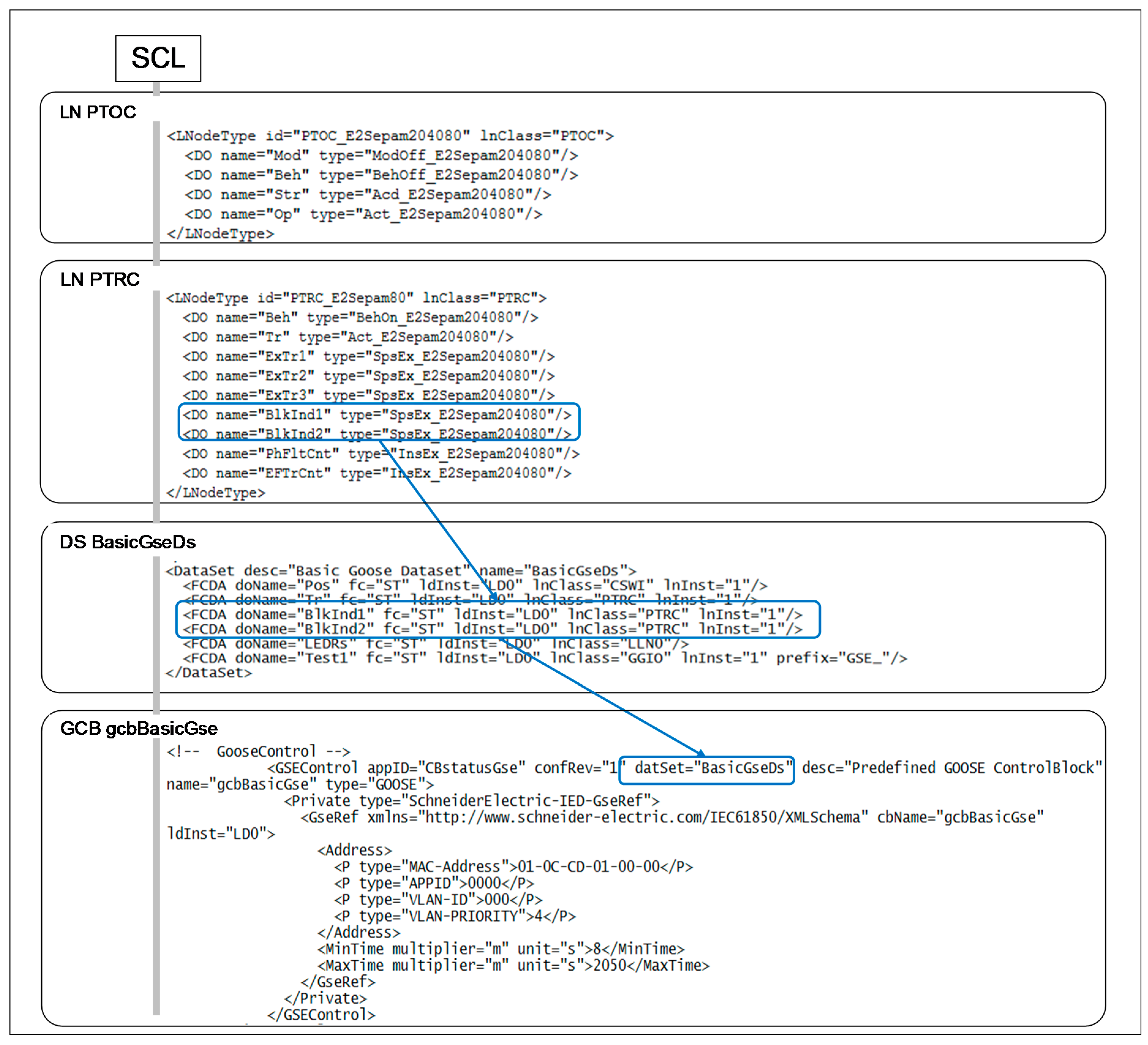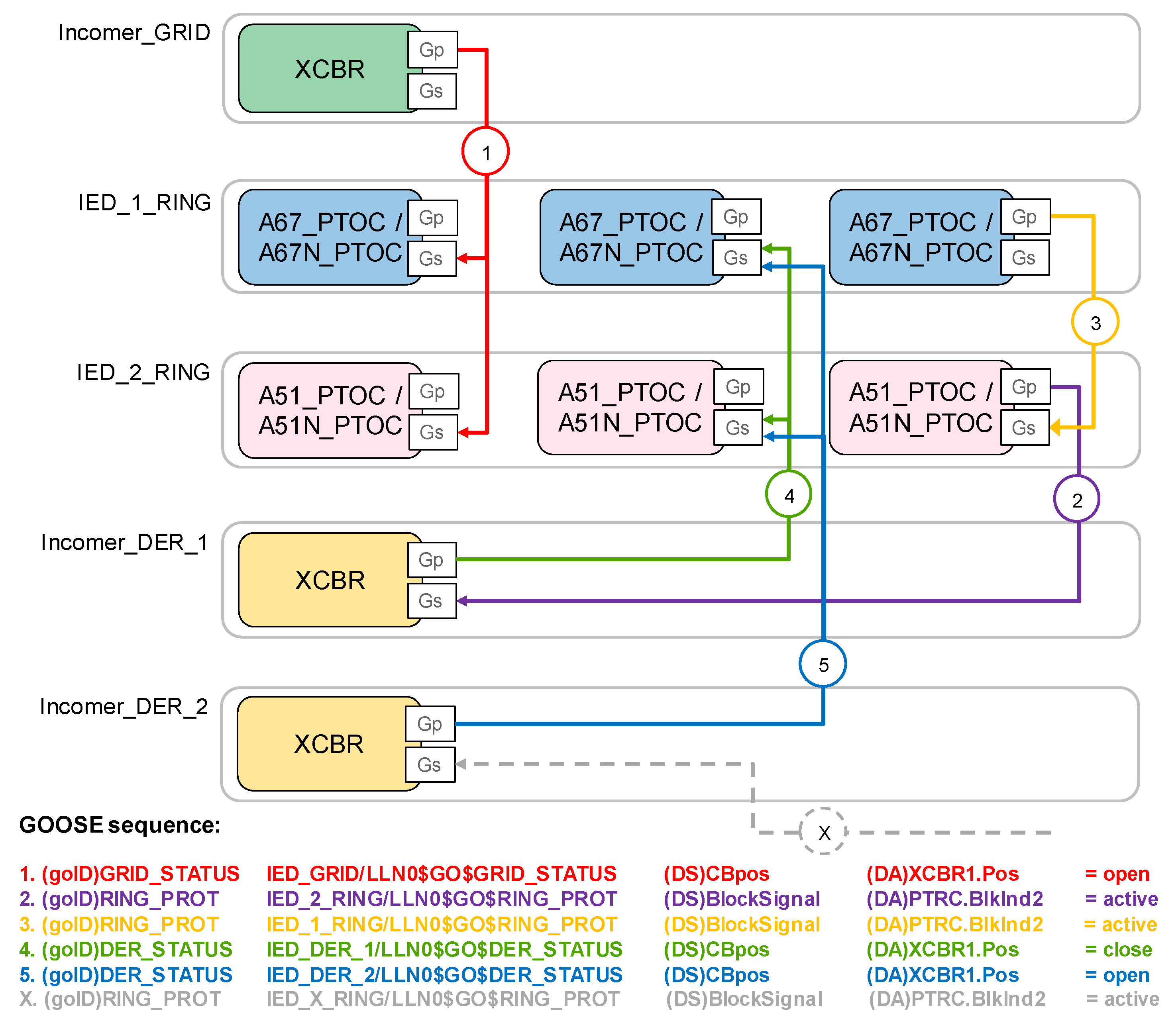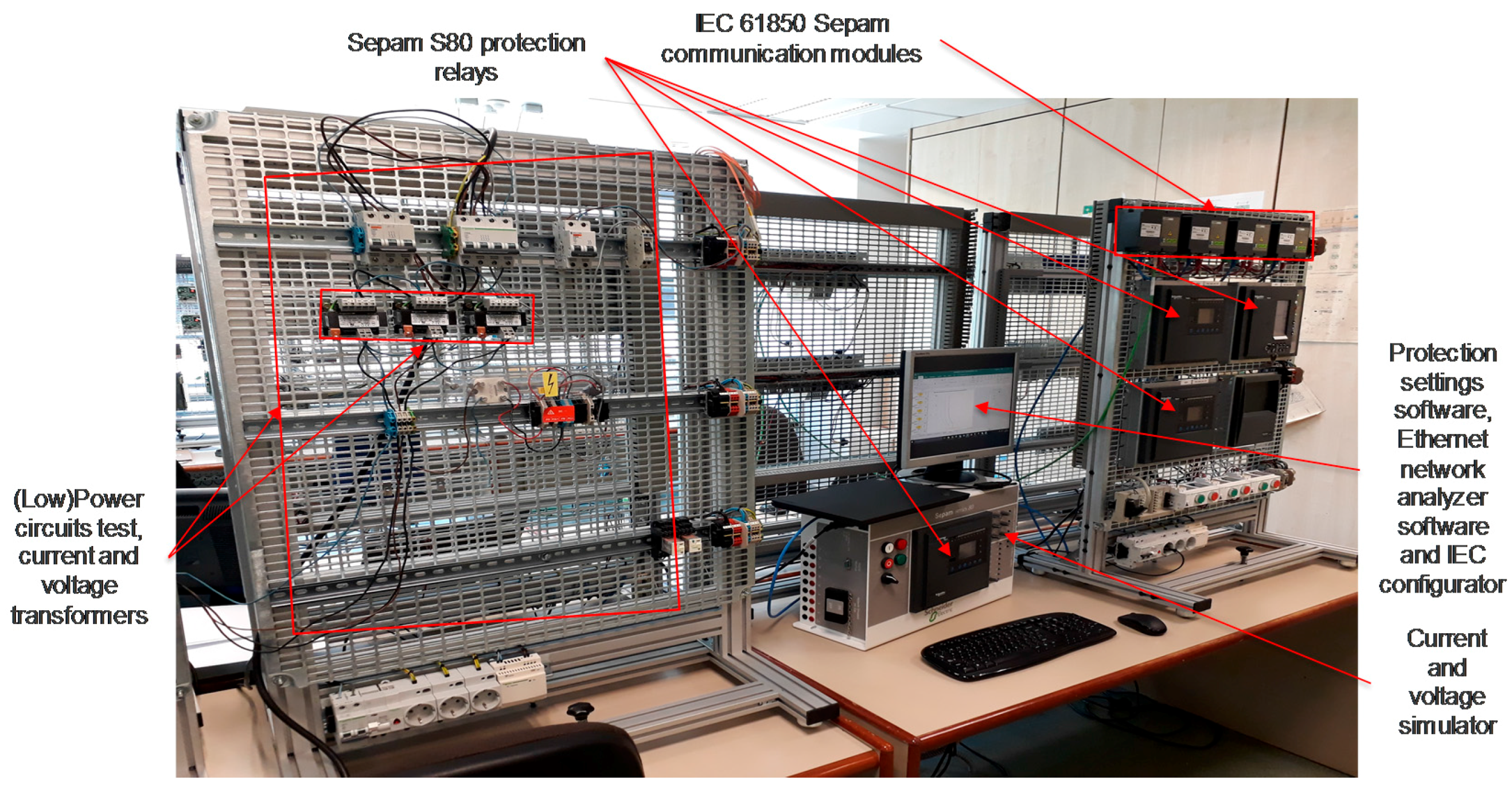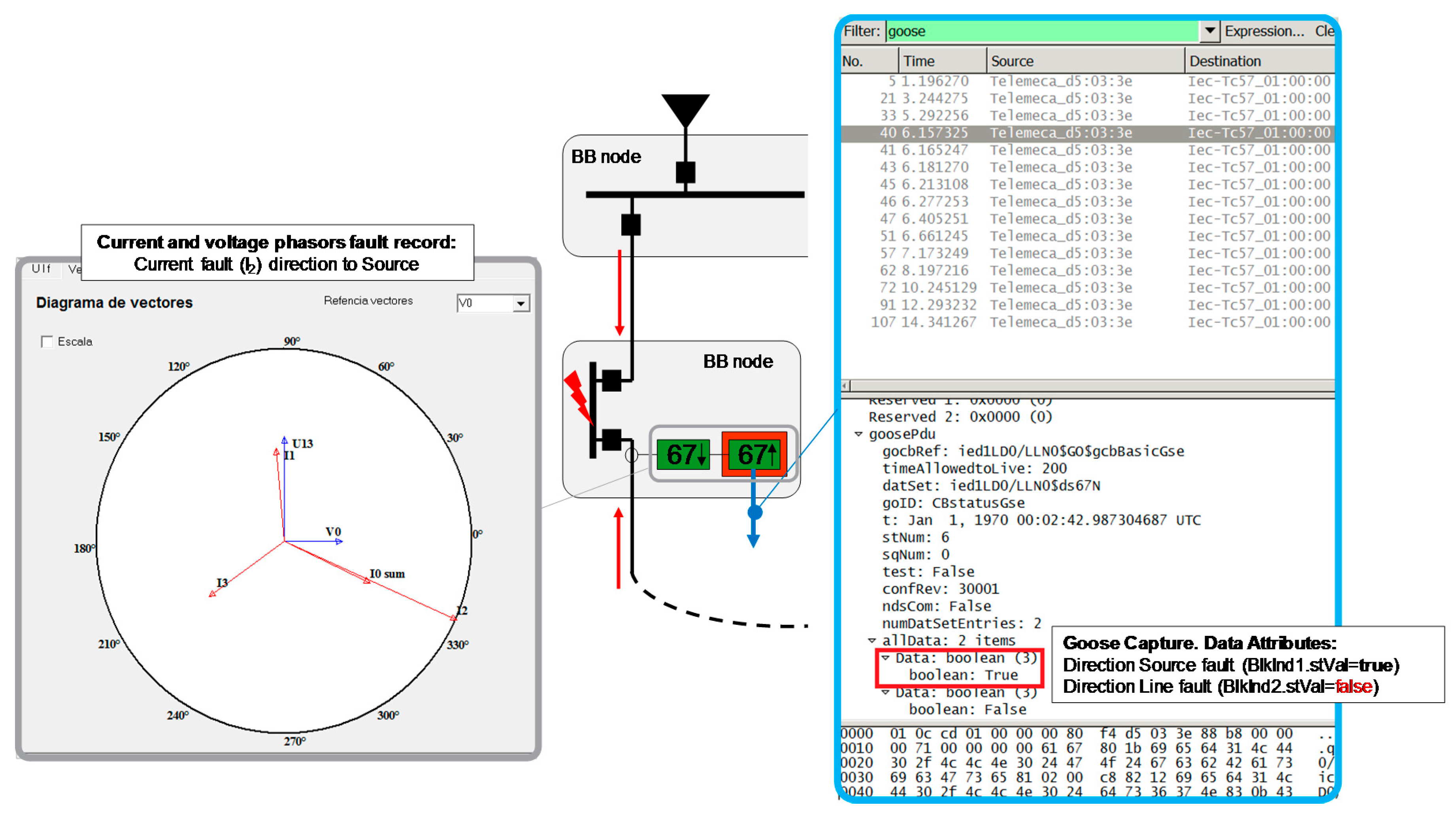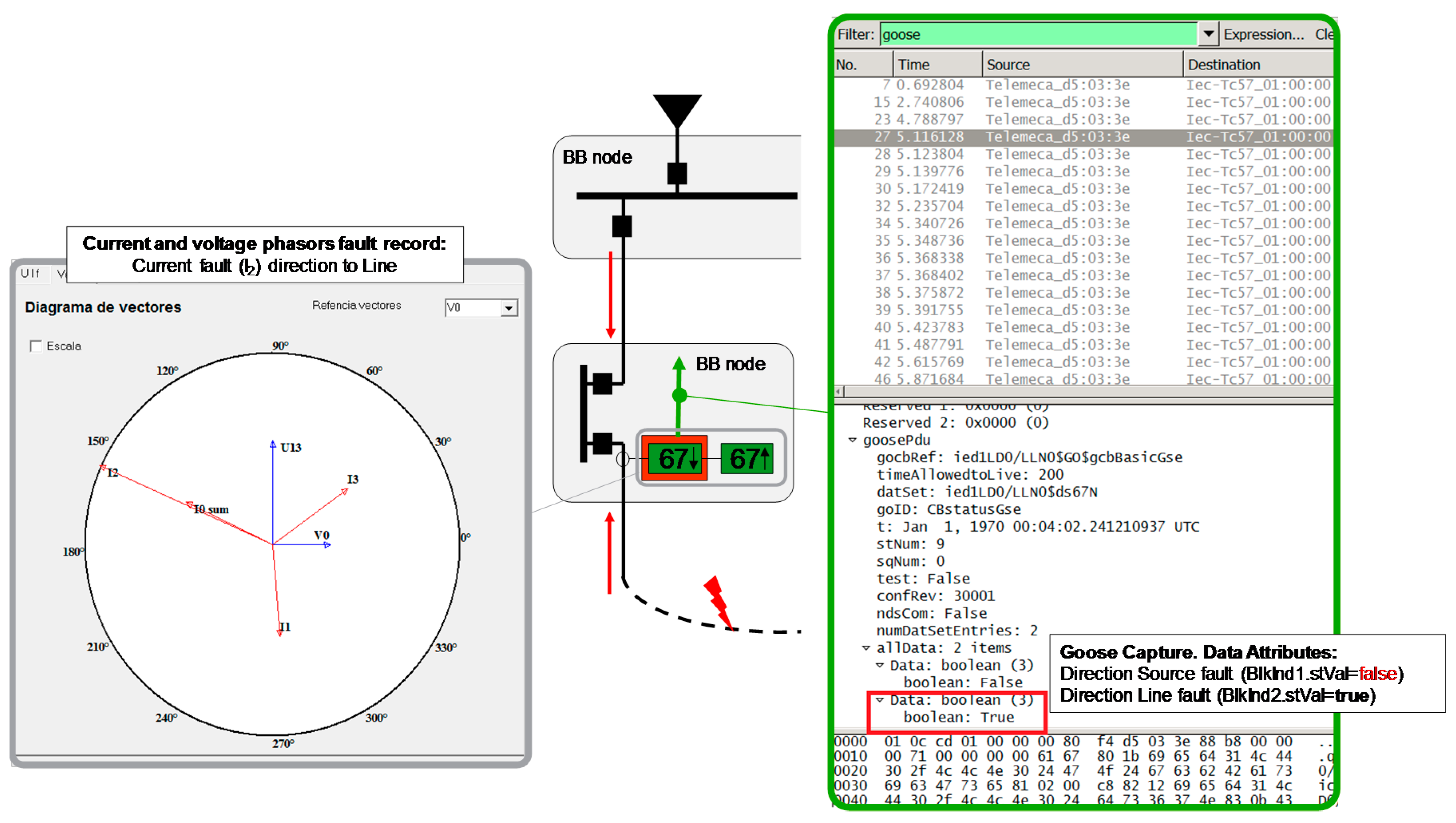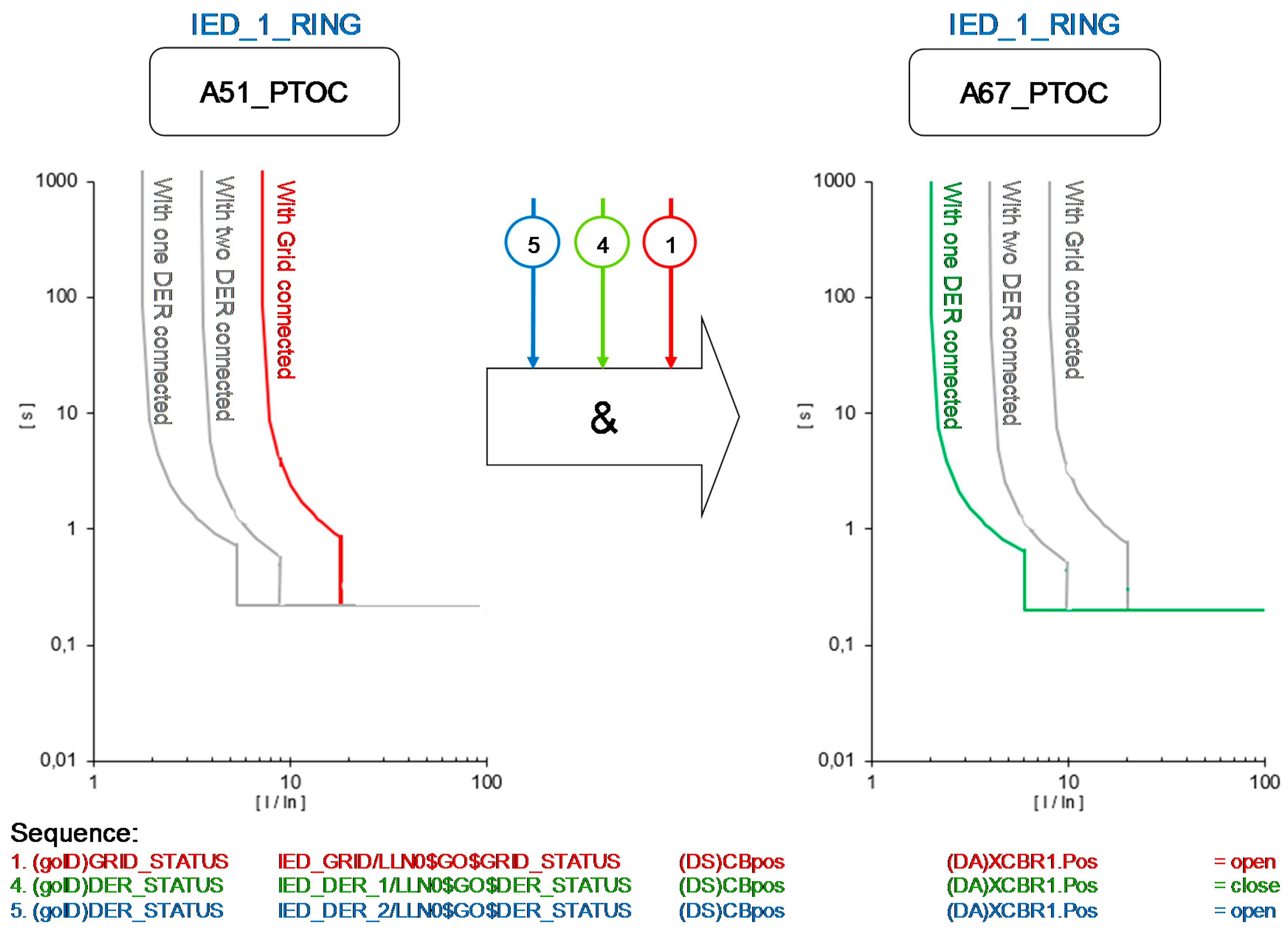1. Introduction
The concept of Smart Grids has been considered in the last years as the appropriate answer to address the new challenges in the energy domain: network reliability, energy efficiency, distributed renewable energy sources and the increasing network complexity. However, multiple barriers appear in the road to realize these achievements. Proactive operation of the grid, efficient integration of demand and renewable generation into grid operation, or the integration of Smart Grids with other energy networks still need additional resources to get applicable solutions.
Moreover, the increasing penetration of Distributed Energy Resources (DERs) demands the evolution of the traditional control and protection schemes of electrical energy systems. Traditional protection schemes are evolving in new functionalities thanks to the emergence of standards such as IEC 61850 and the usage of Ethernet-based communication capabilities. They are necessaries to success in new electrical energy system topologies that are coming with the increasing penetration of renewal energy sources distributed around the Smart Grid.
The protection relays’ evolution to the current Intelligent Electronic Devices (IEDs), which include measurement, protection, control, fault recording and reporting, allows fast and efficient system management. That is possible because of their capability for providing and communicating more data and increasing the Smart Grid distributed automation versus the traditional centralized nodes.
Research work has been presented in [
1] proposing the application of IEDs and their communications capabilities on traditional protection schemes. Indeed, there is a research trend focused in the evolution of Fault Location, Isolation and Restoration System (FLIRS) applications and adaptive protection schemes as a part of the automation in the future smart grids and micro-grids. Several research articles [
2,
3,
4,
5] have revealed projects developing self-healing functionality in mesh grids after a fault location using IEC 61850 services in directional protection schemes. All these functions are included in Advanced Distributed Automation (ADA) systems, which are necessaries to cover the increasing penetration of DER in the grids.
In previous research steps, the authors worked on the analysis of different communications options for efficient and flexible deployment of novel Smart Grid services at the distribution level towards the Software-Defined Utility (SDU) concept [
6], with the objective of obtaining a higher software-based and automated management of the grid and reducing its operational cost. As stated in [
6], SDU strategies send messages with stringent reliability demands between different points of the electrical distribution network with delay requirements of a few milliseconds, which force the communication network to react in a similar response time in case of failure. Thus, many of the SDU services have stringent requirements in terms of availability and delay [
6,
7]. For example, in the European project FINESCE, SDU claims are not always considering their extension to the power distribution network and thus they were confined to the primary substation. This was mostly due to the difficulties arisen from the distributed, complex and partly buried nature of the distribution network in addition to its partially meshed physical topology. To bridge this challenging gap, distribution network requirements has been defined according to the analysis performed on IEC 61850 among others. From the main master lines of the SDU developments, the authors stress on coping with the stringent Smart Grid ICT requirements and allowing the easy deployment of distributed applications over the grid by following existing standards as much as possible. An example of the SDU paradigm pursues to extend the Primary Substation protocols to its surrounding distribution area by creating an IEC 61850 centric system that allows to consider the defined area as a virtual substation from the communications point of view. Following this line of thought, the approach proposed in [
7] for communications over the distribution network is to focus on the development of a novel and flexible ICT infrastructure based on a mix of heterogeneous Ethernet link layer technologies.
Previous articles [
6,
7] have disclosed that intelligent electronic devices operating with the IEC 61850 protocol and that any other protocols for accessing data are translated to the mentioned protocol before storing the data in the repositories. The enablement of Generic Object Oriented Substation Event (GOOSE) messages defined in the IEC 61850 standard in the whole domain is also relevant, even outside of the Primary Substation. In [
7], it was highlighted that the low latency and very high reliability needed for Active Protection Functions can be difficult to achieve with the GOOSE protocol. However, it also remarked the high reliability needed for Command & Regulations and Monitoring & Analysis functional classes, which are not easy to achieve in practice in a distribution grid environment over Ethernet protocol. In summary, although there are some publications such as [
8], which presented a method that can communicate several nodes in a microgrid by means of IEEE Time Sensitive Networking and GOOSE messages, the demonstration of GOOSE capabilities in these concerns is still an uncompleted scientific study regarding the communication in a SDU paradigm.
Taking into account this background, this paper focuses on validating and evaluating the usage of IEC 61850 in the configuration and deployment of phase directional protection and earth fault directional protection cases, respectively called 67 and 67N in ANSI codes. Notwithstanding, although it focused in these specific cases, it also represents a very valuable study for the SDU deployment, exploring how IEC 61850 GOOSE service can be configured and applied to different protection cases, but also provides a proof-of-concept of how other SDU applications could be adapted for running with a communications layer directly over Ethernet.
The rest of the paper is organized as follows:
Section 2 introduces the directional protection, ANSI 67/67N and details its usage over 3-phase systems.
Section 3 summarizes the different models and services provided by the IEC 61850 standard, presents the potential usage in combination with ANSI 67/67N for adaptive protection of electrical systems with DER and reviews related work of this research topic.
Section 4 specifies the configuration and implementation process of the testbed, and
Section 5 exposes and analyses the obtained results. Finally,
Section 6 presents some conclusions and further work to be undertaken.
3. IEC 61850 and Its Usage for Directional Protection
International Electro-technical Commission (IEC) 61850 is a data model and communication architecture standard that allows the interoperation in automation systems in power systems.
The IEC 61850 standard is becoming the most common communication solution in EES of many countries. The standard provides the features and services needed to make this standard the tool for devices’ communication and automation.
The strengths of IEC 61850 are standard modelling object-oriented equipment belonging to the EES and communication services it offers [
16]. This communication services offers a dialog both between IED devices, known as the horizontal communication, and between IED devices and the Supervision and Control platforms, known as vertical communication.
3.1. IEC 61850 Data Model
IEC 61850-7-4 part of the standard describes the data model hierarchy. Its target is to virtualize the IED devices in a common object-oriented based model. It defines a hierarchy that is based on a decomposition of the information contained in the devices, through assemblies and subassemblies, to reach the smallest information unit. The set of information that represent the hardware is named Logical Device (LD). The Logical Nodes (LN), which are subsets of LD, represent physical or functional parts of the device. As an example of the LN, the LN MMXU is related with measurement and it contains all the variables measured on the device. Within the LN, there is the Data Object (DO) that includes all data forming the LN. Analogously, the DOs in the LN MMXU are phase-phase voltage (VPP), phase-neutral voltage (PHV), intensity (A), frequency (Hz), etc. Finally, DO ends in the structure of the Data Attributes (DA). DAs in MMXU are, for example, the value of the above magnitudes of DO (V, A or Hz respectively), the quality bit (q) which represents that the value measured is valid or within the defined ranges, and the time stamp (t) which represents the moment in which the measures have been realized.
The standard defines the common structure of LD, LN, DO and DA for all devices in the market, but keeps free the grouping of different LN into groups and subgroups according to functionalities of equipment, such as Measures, Protection, Control, States, etc.
Figure 7 shows the virtualization and data model of a medium voltage (MV) cabin and its IED device.
3.2. IEC 61850 Abstracts Models and Communication Services
IEC 61850-8 and 9 standard parts describe the set of communication models and services in order to allow the exchange of the data model information between different IED in electrical power systems. The goal is the deployment of automation of the electrical system by sending data groups of different IED LNs.
Figure 8 shows the abstract models and communication services defined in the standard. Finally, they are mapped or encapsulated over an Ethernet network frame.
The first three models are based on a client-server model. The server is the device which contains the information while the client accesses it. Reading and writing models are used to access data and their attributes. The control model is a specialization writing service, which allows management of attributes that are defined in this class, and it allows action on the device. The reporting model is used to exchange a set of event-oriented information, which is transmitted spontaneously when the data value is modified. Today, all these models are mapped over MMS Ethernet protocol in the OSI layer 7.
The other services are based on a publish-subscribe model. In IEC 61850, the term peer-to-peer communication is introduced to emphasize that communication between the publisher and the subscriber involves communication between devices. These communications services are used for the exchange of critical information. The device, which is the source of information, publishes it, and any other equipment that needs this information can receive it by subscribing to it. The GOOSE service is a fast transmission of event information to multiple devices. Instead of using a communication service with receipt confirmation, the information exchanged is repetitively sent for ensuring the arrival to the subscriber. Sample Value (SV) transmission service, is used when is needed to transmit analog field signals, such as current, voltage or any of its derivatives, using digital communications. The analog signals are sampled and transmitted. Both the GOOSE and SV services are encapsulated in OSI layer 2 Ethernet.
On the other hand, the standard allows for an evolution in communications technology, because their models and information exchange services are abstract and uncoupled from the protocols that implement them (MMS, TCP/IP, etc.), which helps to improve communications technology without affecting the standard model and services. An example of this is that the standard is working to provide the mapping of client-server model in Web Services, replacing the MMS.
3.3. GOOSE Service
Conceptually the GOOSE service is implemented to substitute the traditional signal wiring in the control systems, and to add new functionalities. GOOSE provides several advantages over traditional wires:
traditional wiring is substituted by a medium only for communication,
a GOOSE can carry more information that a simple cable,
protection, supervision and control applications use the same physical medium,
VLAN and QoS implementation capabilities.
As it was mentioned before, a GOOSE message is based on publish-subscribe pattern. Publishers send GOOSE messages to multicast MAC addresses across the Local Area Network (LAN), and subscribers just listen to what information is in the network and pick the GOOSE messages to which they are subscribed. IEC 61850-8-1 specifies a retransmission scheme to achieve a highly dependable level of message delivery.
Figure 9 shows the mechanism of retransmission of GOOSE messages. According to [
17], once started, GOOSE messages are published constantly, containing a collection of information called a data set. During configuration, each GOOSE message a
max time parameter (T0-seconds) is given between message publications. The messages are published each time one of the data set elements changes or if the
max time expires. After a data set element changes, the time of transmission between messages is very short, and a
min time parameter (T1-milliseconds) is defined in the GOOSE message. Consequently, the messages are sent very often to increase the likelihood that all subscribers will receive them across the nondeterministic Ethernet. After the initial fast publications, the time of transmission grows longer (T2, T3, Tx) until it reaches
max time again.
Also, in GOOSE message a VLAN can be defined, in order to segregate the paths where the GOOSE is transmitted on the LAN, and a priority tag (QoS) can be also specified, to add high priority to the GOOSE message over other frames in the LAN, and avoiding potential delays of this critical message in saturated networks.
The use of IEC 61850 GOOSE service instead of traditional wiring in the ANSI 67/67N protection system offer an optimization of the installation cost, better performance of the system and more options of distributed automation in the ring main topology systems. Several publications [
18,
19] consider that the usage of GOOSE can reduce considerably the installation costs taking into account that only one Ethernet network is required for the whole system. It increases the possibilities to establish any combination of variables using the same network.
3.4. Related Work on IEC 61850 for Protection Communication and DER Integration
The application of GOOSE service has been verified in publications such as [
20,
21,
22,
23], in which this kind of IEC 61850 message is used to make a logic discrimination, transfer application and modify settings between protection relays, IEDs [
24,
25,
26]. GOOSE service has been proposed as an important tool in order to carry out new enhanced automation in electrical network. For example, reference [
20] defines a Virtual Power Plant (VPP) model in which IEC 61850 can be used to enhance the interaction with DER, contributing to seamless integration of the DER data to a VPP and facilitating the integration to market applications. Moreover, references [
21,
22,
23] present different studies about how GOOSE enable fast horizontal peer-to-peer communication between several IEDs. For example, reference [
21] stated that this technology provides very low latency (4–5 ms) allowing to deploy decentralized functions, such as distributed and autonomous microgrid protection. A fast Fault Location Isolation and Supply Restoration (FLISR) algorithm based on IEC 61850 GOOSE messaging was proposed in [
22] to reduce service outage time. However, the algorithm is quite generic it was considered as a starting point for the definition of the algorithm presented in this paper. The advantages of IEC 61850 GOOSE service were also analyzed in [
23], highlighting the replacement of complex network of hardwired connection with an Ethernet network for inter-IED communication at the station level.
Furthermore, reference [
24] analyzed the usage of IEC 61850 for managing Distribution Automation Systems (DAS) and proposed GOOSE messages as an appropriate technology to transmit time-critical information from one source to multiple receivers. The article also analyzed on the configuration requirements and proposed a configuration solution for a DAS case study. Previous work in [
25,
26] also studied the advantages of GOOSE messages for operating MV protection at substation, instead of the more complex and expensive hard-wired schemes. However, they do not present a detailed explanation of GOOSE configuration and the required LNs.
Taking into account that the usage of IEC 61850 GOOSE service is a growing trend in recent literature, it was considered that the specific case presented in this paper provides some outputs and conclusions that can be helpful for other researchers of the field in the future. Moreover, the authors identified also an increasing industrial need for the implementation of adaptive protection algorithms, such as the one presented in the following section. Therefore, the solution presented details configuration schemes (including GOOSE messages and IEDs), processes and the control algorithm in order to efficiently manage protection systems in scenarios with DER.
4. Implementation Process
This section shows an example of how to implement the 67–67N protection using IEC 61850 GOOSE service communication. For this purpose, and as an example for facilitating its configuration, the Sepam S82 IED [
27] from Schneider Electric (Paris, France) is used, which integrate both protections, and his IEC 61850 integration tool.
However, it must be said that this section focuses on the IEC 61850 integration and does not cover the overall protection configuration. In order to define the parameters of these function protections it will be necessary to develop a discrimination study where the short circuits currents should be analyzed such as in example [
28], where several settings are defined according to different scenarios.
CET850 [
29] is the IEC 61850 integration tool for Sepam protection relay of Schneider Electric.
Figure 10 shows an extract of the data model of Sepam S82 where it is possible to define the IEC 61850 hierarchy and the Time Over Current Protection logical nodes for ANSI 67/67N protections (LN A67_PTOC and LN A67N_PTOC). The number 1 or 2 is referred to the two possible directions of the fault current. The Over Current protection trip condition logical node (LN PTRC1) contains the Block Indication 1 and 2 DO (
BlkInd1 and
BlkInd2) and its DA in order to implement the blocking signal in the application of the ring protection such how it was introduced above. Also, it is possible to see in the
Figure 10 the DO and DA of the protection operation.
The Over Current protection trip condition logical node (LN PTRC1) contains the Block Indication 1 and 2 DO (
BlkInd1 and
BlkInd2) and its DA in order to implement the blocking signal in the application of the ring protection such how it was introduced above. Also the
Figure 10 shows both DO and DA in the IEC 61850 hierarchy.
In order to use the Block Indication information in any IEC 61850 service, it must be included in a DS. In Sepam S82 this DS is implemented and it is called
BasicGseDs. The DS and how it is setting in the GOOSE Control Block are showed in
Figure 10. Also in the GOOSE Control Block is possible to set the GOOSE ID, and the
Min and
Max times.
Once the ANSI 67/67N protection is implemented via GOOSE, it will be necessary the implementation of the algorithm that allows the correct protection of the ring main operation in the particular case where there are DERs as sources and the ring is operating in islanded mode as it was introduced before. There are many solutions but the proposal in this paper follows a modular solution and an interoperable solution which allows different vendor devices to be part of this solution.
Regarding these ideas, the solution is focused in the use of the standard IEC 61850 and its ability to create distributed automation as a part of the new adaptive network protection needs. The proposal for the automation is to change the protection settings of the IEDs according the ring operation mode and the number of the DER units connected to the ring at each moment. Therefore, parameters such islanded mode and DERs presence should be known at each bus bar node.
As mentioned previously, the DERs presence in the network will vary the fault level in island mode (also in network connected, but in this case, the variation is insignificant compared to the fault current contribution of the grid). Its means the settings for detection and trip will be modify according it. Also, the DERs presence, change the electrical configuration of the system from the sources point of view, so it will be necessary to change from ANSI 67/67N to ANSI 50/51 and 50N/51N respectively.
Normally the protection settings of ANSI 67N and 51N have to be modified due to there is a change in earth neutral system when the system changes to island mode. The earth neutral system of the main grid can be different to the earth neutral system of the DERs. This change it will be independent of the number of connected DER in the system.
To carry out the adaptive network, the
Figure 11 proposes an algorithm to establish this real-time adaptive protection system. It is important to highlight the algorithm have to be implemented only in ring IEDs.
The first part of the algorithm analyzes if the system is in island mode and the type of the ring IED. This ring IED can be a part of a busbar node feed by source or not. After this first treatment, the algorithm decides which protections must be activated.
Once the protection configuration system has been decided it will be necessary to adapt the new protection settings. In order to do this adaptation, each connected DER to the system will contribute in different way to the fault level. So, these possible DER combinations are in following truth table,
Table 1, where
is a ℕ number which indicates a fault level in the ring and
is the value of the DA Incomer_DER_X.XCBR1.Pos.stVal from each incomer DER. In fact,
is the result of a function whose variables are the presence of each incomer DER as indicate Equation (1). A low value of
will indicate a low contribution fault, for this reason it is be important to sort the truth table according DER combination in the system.
Therefore, every combination has to be simulated to know the fault impact in the system in order to assign the correct value of
.
After assigning a contribution level
in each combination, the new settings can be selected in each IED. Due to possible limitations settings in each IED for protections ANSI 67 and ANSI 51 protections it will be necessary to establish some levels. The setting level
is defined according to Equation (2) where
is a parameter which establishes the difference between every level,
is the value of setting in [A] and
is the number of settings to establish in each ANSI protections. The
value obtained before will help to select the appropriate setting for each protection:
To carry out the association of different λ value and number of settings will be necessary to simulate the short-circuit capabilities for every DER combination. It is important to remark that the first protection setting will be in order to avoid a blank setting in the protection in the case that is 0 where the phase fault will be 0 due to there is not generation. In fact, is a blank value.
As mentioned before, there are different IEDs in each bus bar node such as ring, DER and main grid IEDs. The
Table 2 shows the data information associated in the DS which will be published through GOOSEs according each IED. It does not only show the information necessary to modify the settings in each ring IED besides, also it shows the GOOSEs and the data for the blocking signal protection system explained before. In the example proposed in this paper, the letter X represents what DER source is connected from in the incomer IED, or the position of the CB in the ring IED (used for the correct logic discrimination protection implementation).
Figure 12 shows a conceptual representation of the GOOSE messages that are published (Gp) by the different IEDs to the communication network and the subscription receivers (Gs) of these GOOSE messages by the other IEDs, in order to implement the automation algorithm.
The ring IEDs will subscribe to GOOSE messages in order to modify settings and besides execute the logic discrimination in the system protection. It is important to remark that the incomer GRID and incomer DER IEDs will only publish to GOOSE messages in island mode.
The GRID_STATUS GOOSE provides information to the other IEDs about the operating mode. On the other hand, DER_STATUS GOOSE provides the information about the presence of the incomer DER_X in the ring. This information will get to the Gs of each ring IED and it will change the protection configuration and settings (S).
Figure 13 shows a part of the GOOSE publication and subscription between several IEDs of the ring. In fact, the incomer IED publishes the status of its circuit breaker through a GOOSE in order to enable or disable the directional protection in ring IEDs 1 and 2. In the other hand, the DER incomers publish a GOOSE message in order to modify the settings of several PTOC protections of ring IEDs mentioned before. Finally, the discrimination system protection is running properly thanks to the GOOSE service that publishes the blocking signal between ring IEDs and the DER incomers.
5. Results
A laboratory mock-up in the Schneider-Electric Spain Headquarters (Barcelona, Spain), shown in
Figure 14, emulates real client installations and was used in early states in other to design and validate the directional protection before its implementation in the field. This environment helped to identify the research need and proposed solution in ring main with DER, detecting incorrect fault detection issues in the emulation of real cases (i.e., low fault current levels in the case of islanding operation of the ring main with DER). However, the results presented in this paper are mainly based on simulations for two reasons. First, is that due to privacy issues the data used in the laboratory coming from real scenarios had legal limitations. Second factor is that simulation method used for the paper can be reproduced by other researchers of the field, and allows comparison with future improvements and the obtained results (not exclusively by the authors).
It is necessary to highlight that the adaptive protection system and its automation presented in this paper is developed in the station level of the installation and the communication between IEDs (horizontal communication). It means that the protective system is a decentralized logic (islanded from the design) system, which is independent from superior logical entities or control centers. It works autonomously between the IEDs defined for that target, regardless of the electrical power configuration. When the number of IED participating in the protection system and the algorithm are defined, the different cases of islanding are studied and it is determined the finite number of scenarios taking into account in the implementation of the solution. In addition, it is necessary to add that the target of this paper is to study the microgrids, where the distribution system is based in ring main. The protections and settings used in the test have been extracted from a real critical protection installation. A short-circuit discrimination study has been done for this end-user installation.
Moreover, the protective system is based in an Ethernet communication network. It means that it is necessary to consider, as in every Ethernet implementation in the industrial environment in a critical power system, the redundancy and back-up power supply for all the devices of the system (IEDs, CB motor supply, switches, and others control and protection equipment) to ensure the reliability of the system. Ethernet redundancy protocols are also used such as (RSTP, HSR, PRP, etc.) in order to avoid the failures in the communication network. Thus, to fully understand the application of the ANSI 67/67N using GOOSE service several tests were realized and results are shown as follows.
Figure 15 shows a simulation of a phase fault in the phase 2 of a power system. The tested Sepam senses the fault current direction to line and it sends to the opposite direction the blocking indication 1 (
BlkInd1) to block the action of adjacent IED. After the setting time, the CB associate in order to isolate the fault relays opened. By means of an Ethernet conventional network analyzer software, it was captured that the blocking indication 1 (
BlkInd1) is activated and it triggers a set of GOOSE.
Figure 16 shows the same phase fault but in this case the tested Sepam senses the fault’s current direction to source. Now, it sends to the opposite direction a blocking indication 2 (
BlkInd2) to block the action of the adjacent IED.
Also, after the setting time, Sepam opened the CB fault. This time, the Ethernet network analyzer capture shows that it is activated the blocking indication 2 (BlkInd2) and it triggers another set of GOOSEs, while the blocking indication 1 keeps false.
In addition, it was checked that both block indications return to the inactive state after blocking time of its activation. It allows that in case the CB down is not operating, the next one is ready to trip after this time.
Figure 17 shows the sequence in the case of CB (CB2) open failure and the action of the adjacent CB (CB1), according IED algorithm in [
30].
The algorithm provides changes in settings protection and even the kind of protection in order to adapt the IEDs to each new scenario. As shown in
Figure 18, the IED_1_RING changes the kind of protection and the settings after receiving the change of the GOOSE services from Incomer GRID and incomer DERs 1 and 2.
In this example, the status of the circuit breaker of the Incomer Grid is opened and then the network is on islanding mode, being the DER 1 connected to the network and DER 2 is disconnected. Therefore, this status provides a change in overcurrent level ANSI 51 from 400A to 100A and in short circuit level ANSI 50 from 1000A to 300A. It is necessary to remark that the kind of protection has also changed from directional protection ANSI 67. Obviously other kind of protections have been implemented, such as voltage protection ANSI 27 or frequency protection ANSI 81, but it has not been linked with this algorithm. The values have been extracted from real end user installation where the algorithm has been implemented although for reasons of confidentiality is not possible to mention the name of this installation.
The application of GOOSE service provides several benefits to the electrical system not only for the protection system but also at the global level of the project. Therefore, some of the benefits of logic discrimination using IEC 61850 GOOSE service are highlighted in
Table 3.
Table 3 compares the difference between both discrimination systems and defines approximately obtained benefits through field experience of the authors and analysed references on this document. As mentioned before, the process explained before has been implemented in a real end user installation where more than 80 IEDs are connected in an Ethernet communication network using the standard IEC 61850. Specifically, 20 of these IEDs are using the GOOSE service in order to establish the exposed protection system before.
After to use this kind of system in several projects it is important to remark that the savings has been approximately in 90% because the dedicated signal between IED has been replaced by GOOSE configuration in IEDs. Additionally, it is possible to find an installation cost reduction about 30%. Although the total cost reduction is emphasized when there is a distance between bus bar nodes more than 100–150 m and they are not in the same room.
The emission times of GOOSE messages are in the range of 2 ms to 4 ms. Even the Ethernet network is non-deterministic, using nowadays redundancy network protocols as HSR and PRP with 0 s [
31] of recovering time, the transmission time of the GOOSE in the networks is taken as deterministic over the configuration time. Nevertheless, a digital contact in a IED has a contact time about 4 ms and if there is a long distance, as mentioned before, it will be necessary to use other kind of conversion hardware to send the binary signal between relays, and then the time will increase considerably over 20 ms. For this reason, the latching signals which have been exposed before will have a reduced time, about 70%, in comparison with traditional wiring.
In general terms, the use of IEC 61850 in this kind of installations can help in system cost reduction during the engineering process of the project as mentioned in [
32] or during the maintenance of the ownership in [
33]. The configuration tools contribute considerably in these processes reducing the time and obviously due to the different vendors’ devices provide the same objects hierarchy description. However, all these advantages require basic communication knowledge from engineers, integrators and maintenance workers, versus the easier wired systems.
6. Conclusions
This paper presents the detection basics of ANSI 67/67N protection and its use in a ring main system based on automatic circuit breakers. It is combined with the implementation of GOOSE service in ANSI 67/67N and adaptive protection solution was designed, detailing its configuration settings and testing and validating its deployment in different cases.
For this purpose, laboratory tests and real installations emulation were deployed. In those tests all the system design and configuration details were specified in order to help to understand how IEC 61850 GOOSE service can be configured to simplify the integration with electric protection systems and provide more flexible and adaptive solutions. Moreover, a control algorithm is defined showing how to set the Blocking Indication DAs triggers in GOOSEs in order to implement the directional blocking signals in the IEDs of the system. In summary, the obtained results in the simulation of the proposed solution show the benefits of using IEC 61850 instead of the hard-wired network connections in terms of the cost of the infrastructure, outage time reduction and the system flexibility, and the paper validates and evaluates a use case example of the IEC 61850 GOOSE service for facilitating an adaptive 67/67N protection configuration.
In addition to this, although the use case is specific for this scenario, this research continues the study and analysis of the data transmission possibilities for building up novel communication paradigms and architectures in the Smart Grid, and can guide the implementation and deployment of several SDU applications for the automation in microgrids and smart grids at distribution level.
In future work, the authors plan to study the usage of this type of applications in Wide Area Network (WAN) instead of LAN using R-GOOSE and R-SV for Wide Area Monitoring Protection and Control (WAMPAC) systems.
